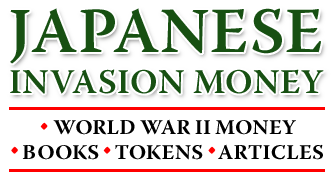 The Collectors Guide to Japanese Invasion Money by Gregory Hale, First edition, published by Centaur Media and printed by Getset Media Services ISBN 9780992579906, 180pages, measures 18 x 25cm, $44.95 postpaid in Australia.
The Collectors Guide to Japanese Invasion Money by Gregory Hale, First edition, published by Centaur Media and printed by Getset Media Services ISBN 9780992579906, 180pages, measures 18 x 25cm, $44.95 postpaid in Australia.
Japanese Invasion Money is known by banknote collectors as JIM. Researching previous publications on the subject, I do not think there has been much new information published in book form for a number of years. There are magazine articles and chapters in some of the military numismatic tomes that have been released on the last decade, but no book just on JIM. So this is a welcome addition to the numismatic library for collectors of JIM and military banknotes.
Greg Hale of Brisbane has been putting information together for many years both on JIM and associated propaganda leaflets. His interest was first aroused by stories told by his grandfather, who had served in the American Army and saw action at the battle of Buna-Gona in New Guinea.
The book itself is easily identified due to the vignettes taken from banknotes of the series and its size is great; it doesn’t need to be any larger, and any smaller would detract from the illustrations that are an integral part of the information included. The colour illustrations are a good size, although I would prefer to have the all pictures in original colour, as some details such as overprints, lose their authenticity, a necessity when trying to identify fakes.
The contents are divided into the five countries of issue - Burma, Dutch East Indies, Malaya, Philippines and Oceania. Each section includes a quick reference price guide and then detailed descriptions of each denomination. The last eight pages include another copy of the quick reference price guide so that collectors can record their acquisitions.
The values quoted are, at first glance, a little strange, until one realises that the amounts are a percentage of the highest value; this accounts for the dollars and cents on each grade. The amount acts as a guide only, as it is of little concern once the Uncirculated and Very Fine grades are considered.
The matter of the counterfeits and forged overprints are dealt with in some depth. I would like to see some more information given regarding the original and fake Mihon (specimen) overprints, particularly in regard to colour. More detail of the OSS and SOE Allied counterfeits of the Burma, Malaya and Philippines series should be included in the next edition of the book.
The inclusion of the Philippines 100 peso (P116) issued by the Bangko Sental Ng Pilipinas as a JIM note is debatable, but adds interest to the catalogue. The collector would certainly need to question the overprint and any similar note that surfaced, in view of the rarity. In the same way, the inclusion of the proposed Australian Allied Military Occupation Currency specimens and the proposed Australian issue of the BCOF 100 yen note held by the Reserve Bank Archives, while not JIM, is an integral part of military numismatics in SE Asia and adds Australian colour. This is a worthy new addition to the military banknote collector’s library.
By the way, the advertisement in the November issue of the CAB magazine for this book includes only the website >as a means of ordering it. For those who have not caught up with technology and are still on snail mail, order the book through Getset Media Services P.O.Box 631, Albany Creek QLD 4035.

